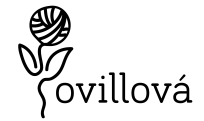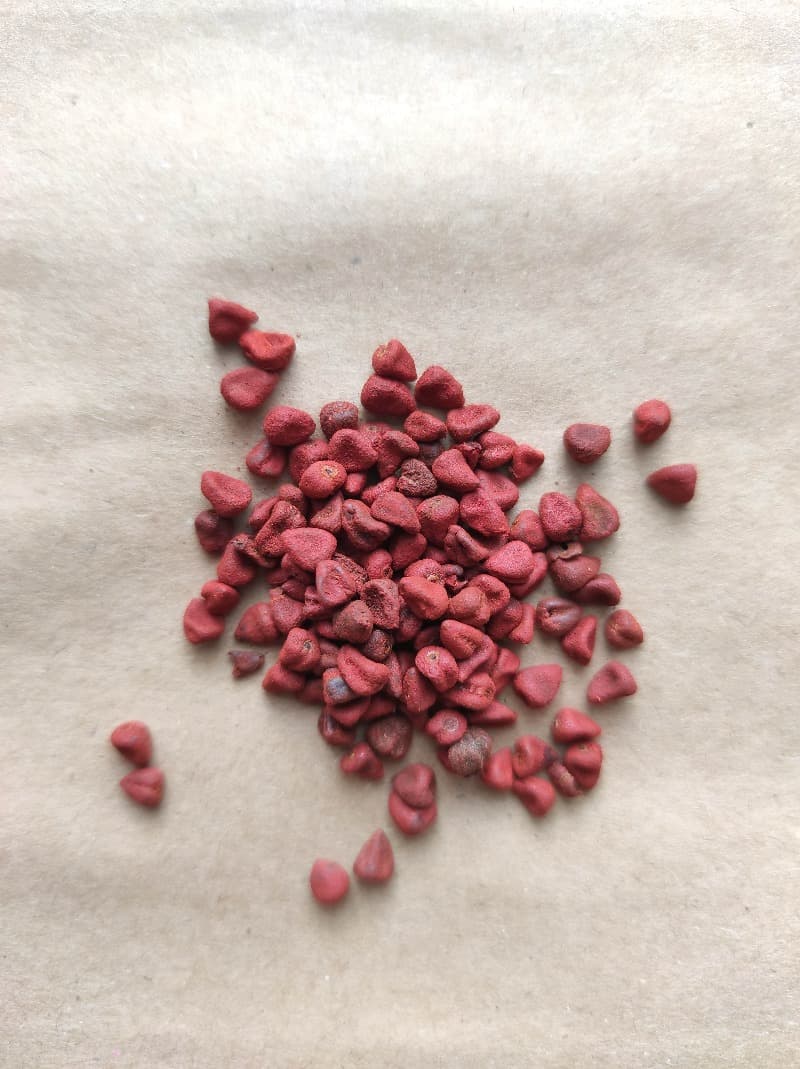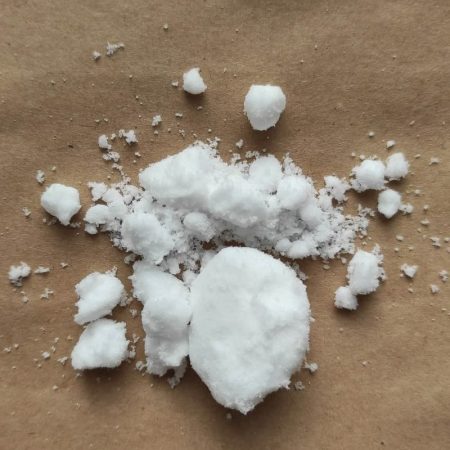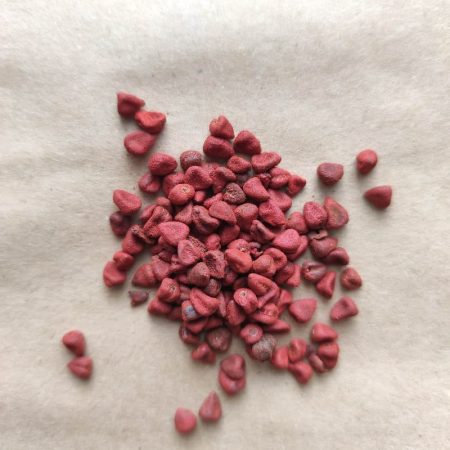Natural dye orange
The natural colorants at hand are usually mainly those of vegetable origin, such as plants, bark, flowers, fruits, seeds, etc. The palette most frequently offered by the use of these colorants contains mostly warm tones, from browns, oranges and ochers to yellows and greens.
For the most intense colors, such as red and blue, we need colorants such as cochineal and indigo. With these colorants we can obtain the other portion of the chromatic circle, i.e., the
red and blue in all its ranges.
The objectives of the use of natural dyes are:
- Do not harm the environment, reducing the use of polluting materials as much as possible.
Annato seeds.
In pre-Hispanic times, the Aztecs and Mayas spiced their cocoa drinks with annato. Its name comes from the Nahuatl word achiotl, which means “red dye”. Containing 6 of the 8 essential amino acids. Not only did it have a culinary use, but our ancestors used to paint their skin. The red paint on the body had several meanings, some books state that it protected from the sun and against insect bites.
It is currently widely used in South America as a food colorant. As a curious fact, the rind of Edam cheese, with its characteristic orange color, is colored with achiote (annato).
Annato also has medicinal properties against headaches. It is healing and was even used to cure measles, among others. It is a natural insect repellent.
…………..
Other options to obtain orange color for dyeing fibers are: dahlia, rhubarb, sandalwood, rubia tinctoria, heather, eucalyptus, onion skin, …
Annato in history
Achiote (annato) is a plant native to Central and South America that has been widely used as a source of natural dye for centuries. In addition to its value as a colorant, annato also has a rich cultural history and has been used in cooking and traditional medicine. Over the years, annatto has left a significant mark on the history of dyeing and has been prized for the vibrant colors it can produce, especially in cotton dyeing.
The history of dyeing dates back thousands of years, when ancient civilizations discovered that certain plants and substances could be used to dye textiles. These natural dyes are obtained from various resources, such as plants, minerals, insects and other organic materials. In the case of achiote, the seeds of the annato tree, scientifically known as Bixa orellana, are used to obtain the dye.
Annato seeds contain a red-orange pigment called bixin, which is responsible for its dyeing ability. The process of obtaining annatto dye involves extracting the colorant from the seeds by grinding and soaking methods. Once the dye has been extracted, it can be used directly or undergo concentration and filtration processes to obtain a more concentrated solution.
What colors can be obtained with annato?
Annato has been traditionally used in textile dyeing, especially in the Central and South American region. Annato dyeing has been especially popular in cotton dyeing, as this fiber is very receptive to dye and can achieve vibrant, long-lasting colors. Annato can provide a wide range of shades, from yellows and oranges to intense reds, depending on the concentration and the dyeing process used.
The advantages and benefits of natural dyes.
Natural dyes offer a number of advantages and benefits over synthetic or chemical dyes. Here are some key advantages of natural dyes:
- Sustainability: Natural dyes are obtained from renewable and sustainable sources, such as plants, flowers, fruits, roots and insects. They do not rely on petroleum-based chemicals and do not contribute to environmental pollution.
- Non-toxic: Natural dyes are generally safe and do not contain toxic chemicals. They are safe for the environment, artisans and consumers. This makes them a healthy choice for textile and food dyeing.
- Unique and subtle colors: Natural dyes offer a wide range of subtle colors and earthy tones. Although they may be less intense than synthetic dyes, their beauty lies in their soft, natural look.
- Connection to nature and culture: Natural dyes have a long history of use in various cultures around the world. Using natural dyes connects us with artisanal traditions and preserves ancestral knowledge and techniques.
- Variety of options: There are numerous natural sources for different color dyes. Each plant or color source has its own characteristics and shades, allowing for a wide variety of options to experiment and create.
- Respect for animals: Many natural dyes are vegan and do not involve animal cruelty. Some dyes, such as those obtained from insects like cochineal, are ethically and sustainably sourced without harming animals.
- Textures and special effects: Some natural dyes, such as turmeric or onion peel, can create special effects and unique textures on fabrics. These dyes can generate shades, streaks and shadows that add beauty and depth to garments.
- Feeling of connection and authenticity: Dyeing with natural dyes involves a slower, more artisanal process. This manual and careful approach connects us with manual labor, patience and respect for natural materials.
Therefore the ecological, health and cultural benefits of natural dyes make them a valuable option for those looking for a more sustainable and conscious way of dyeing textiles.
Dyeing cotton with annato.
In cotton dyeing, annatto is used in different forms. One of the most common techniques is to dip the cotton in a solution of annatto, which may be prepared with water or with other alkaline or acidic agents to alter the color tone. Different mordants can also be used to improve color fixation in the fiber. Annato can be applied to cotton by dipping, printing or even in combination with other dyeing techniques to create special effects.
The colors that can be obtained with annatto vary according to the dyeing processes used. Yellow and orange tones are common, especially at lower dye concentrations. As concentration is increased or more intensive dyeing techniques are used, more intense shades of orange and red can be obtained, reaching vibrant and bright shades.
The use of annatto in the dyeing of cotton and other fibers not only provides beautiful and durable colors, but also has additional advantages. Annatto is a natural and sustainable dye, which means it is an environmentally friendly option and free of toxic chemicals. In addition, annato has been used by various indigenous cultures throughout history, giving it cultural value and a connection to local traditions and craftsmanship.
Dye garden, how to grow Annato at home?
Growing annato at home can be a fascinating and rewarding experience, allowing you to enjoy this versatile and colorful plant. Here are some steps to grow annato in your own home:
- Choice of seeds: Obtain high quality annato seeds. Be sure to choose fresh and healthy seeds.
- Seed preparation: Before sowing the seeds, soak them in warm water for about 24 hours. This will help soften the seed coat and stimulate germination.
- Selecting the right location: Choose a spot in your garden that receives sufficient direct sunlight. Annato prefers warm, tropical climates, so make sure the temperature is suitable for its growth.
- Soil Preparation: annato prefers well-drained and slightly acid soils. Be sure to prepare the soil properly, removing weeds and adding organic compost to improve soil structure and fertility.
- Sowing the seeds: Make small holes in the soil, about 30 cm apart. Place one seed in each hole and cover lightly with soil.
- Adequate watering: Keep the soil slightly moist but not soggy. Water regularly, especially during periods of drought. Avoid waterlogging, as this can damage the roots of the plant.
- Care and maintenance: Be sure to protect young plants from extreme cold and frost. Prune regularly to promote healthy growth and proper plant form.
- Protection against pests and diseases: Achiote is generally resistant to pests and diseases, but you should still be on the lookout for potential problems. If you detect pests, you can use natural control methods, such as the use of organic insecticides or the introduction of beneficial insects.
- Seed harvest: It takes several years for annato to reach maturity and produce seeds. When the seed capsules turn dry and brown, it is time to harvest them. Break the capsules and extract the seeds.
- Use of the seeds: Achiote seeds can be used for future planting or can also be used to make natural dyes. You can grind the seeds and use them to dye textiles or foods, such as rice.
Remember that annato cultivation may vary according to geographical location and climatic conditions. It is important to research the specific needs of the plant in your region to get the best results. Enjoy the process and the colorful contribution that annato can make to your garden!






Reviews
There are no reviews yet.